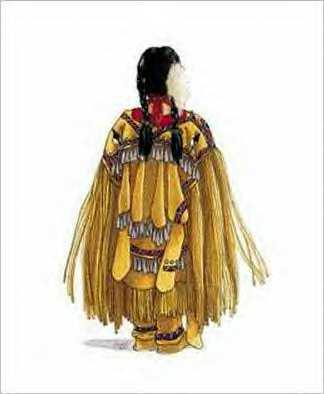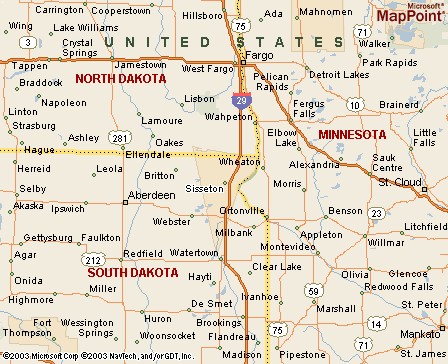|
|
Canku Ota |
|
|
(Many Paths) |
||
|
An Online Newsletter Celebrating Native America |
||
|
December 27, 2003 - Issue 103 |
||
|
|
||
|
Saving dying dialects |
||
|
by Jera Stone, Aberdeen
(SD) American News Writer
|
||
|
"She said, 'the TO box?' " "To," pronounced like "tow," means blue in Dakota Indian language. It was one of Obago-Nicolar's first memories of Felicity speaking Dakota at home after starting the Dakota language immersion program at the Siceca Learning Center on the campus of Sisseton Wahpeton College. "The immersion program grew out of the desire of the Dakota people to do something to preserve the Dakota language," said Bill Lonefight, president of the college. He had been discussing a Dakota immersion language program for a year with Tammy DeCoteau, field manager of the Association on American Indian Affairs' Sisseton chapter.Dakota is the language of the Dakota Sioux Tribe, which lives east of the Missouri River, including the 11,000 Sisseton Wahpeton Oyate tribal members. "She came to me four months ago and said 'I have $5,000, so can we start?' " The college's day care for children of the staff and students was then reformatted around the immersion program, Lonefight said. Getting immersed: On a snowy day this month, the children's singing could be heard outside the center located in a trailer on campus. Only after opening the door would visitors realize that the melodies of the songs might be familiar, but not the words. Some children and the day-care providers were singing "London Bridge is Falling Down" in Dakota as they each crossed under the bridge formed of four arms. In the nearby table, three tribe elders were sipping coffee, watching the children and smiling. In another corner, two drummers were showing little boys how to beat a large drum with leather-wrapped drumsticks. On the walls, brightly colored pictures are posted among papers with lyrics, words and phrases all in Dakota. Lonefight smiled as he picked up a little girl who ran over to give him a hug. The Dakota language is in danger of extinction because of years of boarding schools and the forced assimilation of tribal members into Anglo-American culture, he said. "Less than 10 percent of tribal population speaks Dakota and most of those are over the age of 60," Lonefight said. "Unless we do something, we are very close to having it fade." The center has since secured more funding, including $325,000 to construct a new building for the day care. However, they still need another $100,000 to complete and furnish the building, he said. Language part of identity: Native American tribes are looking to preserve their languages for various cultural and historical reasons, Lonefight said. "Some of those (reasons) are fairly pragmatic, like the ability to communicate with your grandparents," he said. The language is also a substantial part of a tribal member's identity. "The elders repeatedly tell us that some of the solutions for current social problems are imbedded in our languages," Lonefight said. "When people spoke Dakota, they truly knew how to treat one another. They truly understood where they belonged in relation to other people, to the natural world (and) to the spiritual world." Elders help, too: The center has six Sisseton Wahpeton Oyate tribal elders who visit regularly. They help the caregivers and the children with their pronunciations and translate books and songs into Dakota. Because the language has different dialects for men and women, three elders involved are men and three are women. Orsen Bernard, one of the six elders, said he got involved because he wanted to help keep the language alive. "Dakota language is so deep it comes from the heart," he said. "Whatever I say in Dakota, it has a deeper meaning because that's the way the Dakota language is." It is a language without any swear words, Bernard said. Improved abilities: Lonefight said another reason the college is getting involved is the research is proving that bilingual children have added cognitive skills. "They do better in school. They have increased higher order of thinking skills. They are able to make connections." CAT scans have shown that bilingual people use more areas of their brains, he said. "It's a little odd that at the same time schools were pressing children to learn Spanish, French, Japanese and Russian they were pressing the other way to extinguish the Dakota, the Cherokee, the Muskogee and Lakota (languages)," Lonefight said. The loss of the tribal languages could also mean the loss of certain knowledge that's only recorded in those languages such as traditional medicines, he said. The elders have also said that the Native American languages were the way they were taught to talk to God, Lonefight said. "That doesn't mean there aren't other ways, but they were the ways that we were specifically given and (the elders) worry that if we allow our languages to fade we might miss something." The program has been a success in its first three months, Lonefight said. "It's been successful not just in working with the children, but in creating an awareness on the reservation that something practical can be done." DeCoteau, the field manager for AAIA, said parents' reactions have been positive. "Most people want their children to learn the language," she said. The parents receive a copy of the words and phrases the children are learning. A voice recording of the words and phrases is in the process of being created and the college will offer a course on teaching children Dakota next semester. "We are trying to encourage parents to learn along with them," DeCoteau said. "People as adult learners are embarrassed to talk in front of somebody who's fluent. But I think people aren't embarrassed to talk to their children." Delbert Pumpkinseed, another visiting tribal elder, said he enjoys helping the children learn Dakota. "Every morning I get good greetings from them," he said. "They are happy to see us. They give us hugs." Elder Wayne Eastman said he loves seeing the progress children have made in the program. "You tell them to put something away in Dakota and they do it," he said. "They are learning." Alfred Seaboy, who visits the center once a week with his brother Cody to teach the boys to play the traditional drum, said he likes the visits and the idea behind them. "We started playing drums at this age," Alfred said. Cody said he thinks the immersion program idea is great. "I kind of wish I was brought up and taught this way and was able to speak the language better." Obago-Nicolar, chief finance officer of the college, said she is learning Dakota along with her daughter, Felicity. "Every day (she) comes home and teaches me something," Linda said. "I need to keep learning to keep up with her." |
|
|
www.expedia.com |
|
|
||
|
|
||
| Canku Ota is a free Newsletter celebrating Native America, its traditions and accomplishments . We do not provide subscriber or visitor names to anyone. Some articles presented in Canku Ota may contain copyright material. We have received appropriate permissions for republishing any articles. Material appearing here is distributed without profit or monetary gain to those who have expressed an interest. This is in accordance with Title 17 U.S.C. Section 107. | ||
|
Canku Ota is a copyright © 2000, 2001, 2002, 2003 of Vicki Lockard and Paul Barry. |
||
 |
 |
|
|
The "Canku Ota - A Newsletter Celebrating Native America" web site and its design is the |
||
|
Copyright © 1999, 2000, 2001, 2002, 2003 of Paul C. Barry. |
||
|
All Rights Reserved. |
||
 Linda
Obago-Nicolar remembers asking her 4-year-old daughter Felicity
to pick up a blue cereal box one day.
Linda
Obago-Nicolar remembers asking her 4-year-old daughter Felicity
to pick up a blue cereal box one day. 